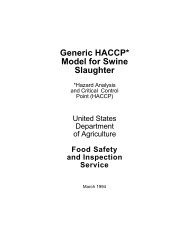Generic HACCP Model for Thermally Processed Commercial
Generic HACCP Model for Thermally Processed Commercial
Generic HACCP Model for Thermally Processed Commercial
You also want an ePaper? Increase the reach of your titles
YUMPU automatically turns print PDFs into web optimized ePapers that Google loves.
HAZARD ANALYSIS/PREVENTIVE MEASURES<br />
PROCESS CATEGORY : THERMALLY PROCESSED, COMMERCIALLY STERILE<br />
PRODUCT EXAMPLE : BEEF STEW<br />
Process Step<br />
RECEIVING -<br />
FROZEN COOKED<br />
DICED BEEF<br />
RECEIVING -<br />
NON-MEAT<br />
INGREDIENTS<br />
RECEIVING -<br />
CANS<br />
HAZARDS<br />
Biological (B) Including<br />
Microbiological<br />
Chemical (C)<br />
Physical (P)<br />
B- Excessive microbial load (staphylococcus<br />
aureus) due to improper temperature and<br />
handling.<br />
C-Antibiotic and pesticide residues.<br />
P- (Foreign Material) - Visible hazardous <strong>for</strong>eign<br />
material that could compromise product safety.<br />
B-Excessive bacteriological (spore) load.<br />
Meat and Poultry Products Hazard and Control<br />
Guide.<br />
C- Pesticide<br />
P- (Foreign Material) - Visible hazardous<br />
<strong>for</strong>eign material that could compromise product<br />
safety; metal, glass , etc.<br />
P- (Foreign Material/Adulteration) - All nonmeat<br />
ingredients, packaging materials, etc. must<br />
be stored to prevent contamination due to<br />
<strong>for</strong>eign material.<br />
P (Foreign Materials) - Visible hazardous <strong>for</strong>eign<br />
material that could compromise product safety;<br />
metal, and other materials.<br />
STORAGE - MEAT B- Insufficient control of cooling during storage<br />
could result in unacceptable levels of pathogens.<br />
STORAGE -<br />
NON-MEAT<br />
STORAGE -<br />
PACKAGING<br />
No significant hazards identified that are likely to<br />
occur.<br />
C- Chemicals<br />
P- Packaging materials are stored in a location or<br />
manner that allows contamination from <strong>for</strong>eign<br />
material or chemicals.<br />
* Not to be included in a plant-specific <strong>HACCP</strong> plan.<br />
20<br />
Preventive Measures<br />
Measure and record<br />
temperature of incoming lots.<br />
Check container integrity.<br />
Supplied by inspected<br />
establishments.<br />
Provided by supplier inspected<br />
establishments and visual<br />
examinations.<br />
Verify that the letter of<br />
guarantee is on file and<br />
appropriate <strong>for</strong> product use<br />
from third party audit of a<br />
supplier or other means.<br />
Suppliers letter of guarantee and<br />
ingredient specification.<br />
Suppliers’ letters of guarantee<br />
and cleaning step.<br />
Monitor the internal product<br />
temperature to ensure that it is<br />
maintained at or below a level<br />
sufficient to preclude microbial<br />
growth.<br />
Verify that packaging materials<br />
are stored separately from<br />
chemicals and are kept covered<br />
and not directly contacting<br />
floors or walls.<br />
Examples of How Hazard Is<br />
Introduced *<br />
B-Transport refrigeration unit is not<br />
functioning properly (out of freon).<br />
B-The shipping container (the<br />
cardboard combo bin) was crushed by<br />
a <strong>for</strong>klift and the immediate container<br />
(the film wrapped around the<br />
individual trays) was torn and<br />
punctured introducing harmful<br />
microbes into the product.<br />
P-Pieces of glass found in product from<br />
a broken light bulb, metal clips, knives,<br />
plastic, etc.<br />
B-Spices have not received a treatment<br />
to reduce or eliminate bacteriological<br />
(spore) load.<br />
C-Improper pesticide usage by<br />
producers and previous processors.<br />
P-Pieces of glass found in product from<br />
a broken light bulb, metal clips, knives,<br />
etc. when received from supplier.<br />
P-Dirt, wood, metal or glass may get on<br />
the cans during storage and shipping if<br />
protective packaging or containers are<br />
damaged.<br />
B- Product is stored in such a manner<br />
that the cooler does not keep some<br />
boxed beef at an unacceptable<br />
temperature permitting excess<br />
microbial growth.<br />
C- Packaging materials are stored on<br />
the same shelf with open buckets of<br />
boiler cleaning compounds.



